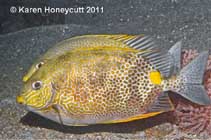| Family: |
Siganidae (Rabbitfishes) |
| Max. size: |
42 cm TL (male/unsexed) |
| Environment: |
reef-associated; brackish; marine; depth range 0 - 25 m |
| Distribution: |
Eastern Indian Ocean and Western Pacific: Andaman Islands, Thailand, Malaysia, Singapore, Indonesia (including Irian Jaya), Viet Nam, Ryukyus, southern and eastern China, Taiwan, South China Sea, Philippines, and Palau. Replaced by Siganus lineatus to the west, south and east of the region described by the said localities. |
| Diagnosis: |
Dorsal spines (total): 13-13; Dorsal soft rays (total): 10-10; Anal spines: 7-7; Anal soft rays: 9-9; Vertebrae: 13-13. Dusky blue dorsally, silvery below; a bright yellow spot adjacent to last few rays of dorsal fin; head with lines and spots. Preopercular angle 91°-102°; strong scales fully cover the cheeks; midline of thorax scaled, not the pelvic ridges. Anterior nostril with extremely low rim, slightly expanded posteriorly. Spines stout, pungent, venomous. |
| Biology: |
Inhabits turbid inshore reefs among mangroves; tolerates or even prefers low salinities. Fry settles in seagrass beds around river mouths and adults enter and leave rivers with the tide, but also found on the drop-offs of inshore fringing reefs down to 6 m. Schools throughout life; school size for adults around 10 or 15. Feeds on benthic algae. Unlike other siganids, this species is reported to be active at night. Sold fresh in markets (Ref. 9813, 48637). |
| IUCN Red List Status: |
Least Concern (LC); Date assessed: 12 March 2015 Ref. (130435)
|
| Threat to humans: |
venomous |
Source and more info: www.fishbase.org. For personal, classroom, and other internal use only. Not for publication.

